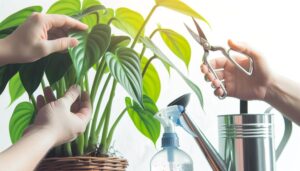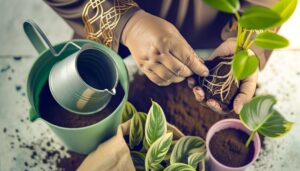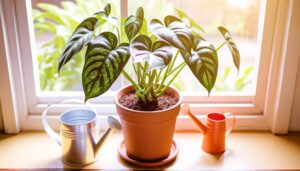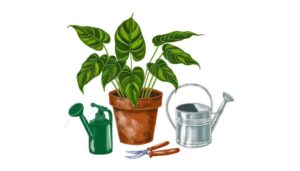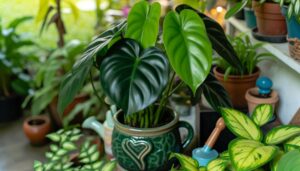What Are the Care Requirements for a Philodendron Billietiae?
Philodendron Billietiae, a member of the Araceae family, thrives under indirect, bright light, preferably at a distance of 6-8 feet from the source. The plant requires consistent moisture, while overwatering needs to be avoided to prevent root rot.
A well-draining soil mix, enriched with organic matter such as compost or peat moss, is essential for healthy growth. Philodendron Billietiae prefers a temperature range of 65-85°F and a humidity level between 60-80%.
Understanding these factors and their interrelation is vital for the successful cultivation of this species. Continue exploring for further insights into its care.
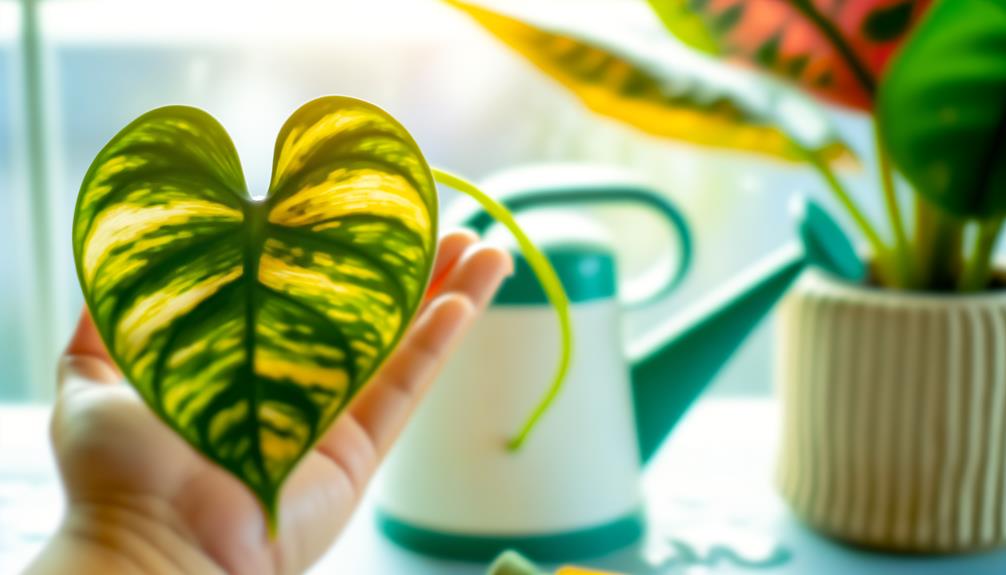
Key Takeaways
- Philodendron Billietiae thrives in indirect, bright light, ideally from a north or east-facing window.
- It requires consistent moisture, but avoid over-watering to prevent root rot and under-watering to prevent drooping leaves.
- A well-draining loamy soil mix with organic matter and a slightly acidic pH is ideal for this plant.
- The plant prefers a temperature range of 65-85°F (18-29°C) and humidity levels of 60-80%.
- Use a humidifier or a pebble tray to maintain ideal humidity, mimicking its natural tropical rainforest habitat.
Understanding Philodendron Billietiae
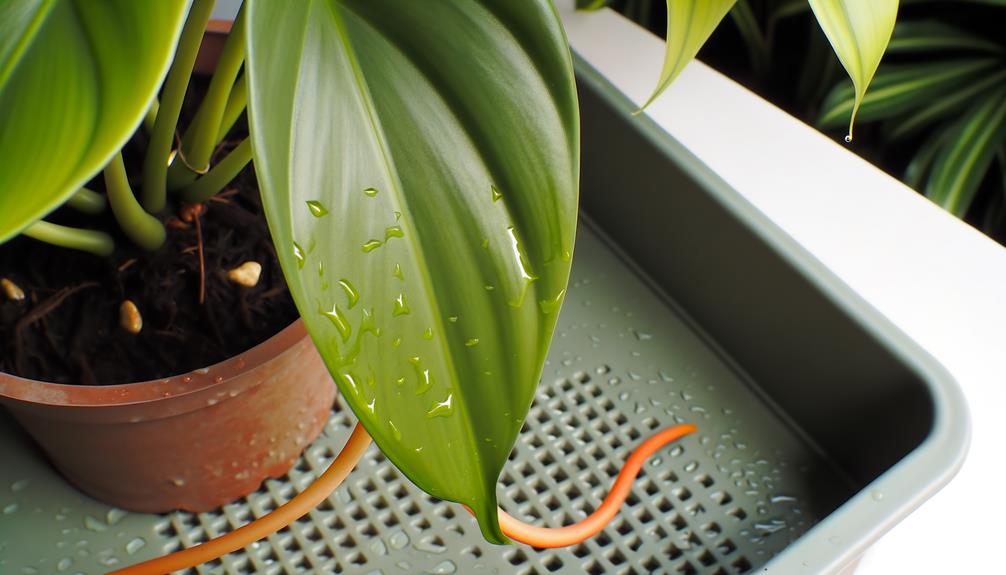
Philodendron Billietiae, a unique species of the Araceae family, is distinguished by its elongated, heart-shaped leaves and vibrant green hue, making it a striking addition to any indoor plant collection.
Originating from tropical regions of Central and South America, this plant exhibits an epiphytic growth habit, meaning it often grows on other plants in its natural habitat. Its foliage is noted for its glossy finish and unique, ribbed texture.
Being a tropical plant, it prefers a humid environment, and its roots need a well-draining potting medium. Regular watering, avoiding both excessive watering and insufficient watering, is key to its growth. Understanding these characteristics is fundamental to providing ideal care for the Philodendron Billietiae, a plant that brings natural beauty and a sense of tranquility to any space.
Ideal Lighting Conditions
Adequate exposure to light is essential for the best growth of a Philodendron Billietiae, with indirect, bright light being the most advantageous. This tropical plant thrives in conditions that mimic its native rainforest habitat, where sunlight filters through the dense foliage overhead.
Direct sunlight can cause leaf burn, hence, a north or east-facing window is optimal to provide the right balance of light intensity. Fluorescent lighting can also suffice, especially for indoor plants. However, maintain a distance of 6-8 feet from the light source to prevent scorching.
Additionally, a photoperiod of at least 10 hours daily is recommended to promote healthy growth. Observe the plant’s response to light changes and adjust accordingly for ideal life force.
Watering Your Philodendron Billietiae
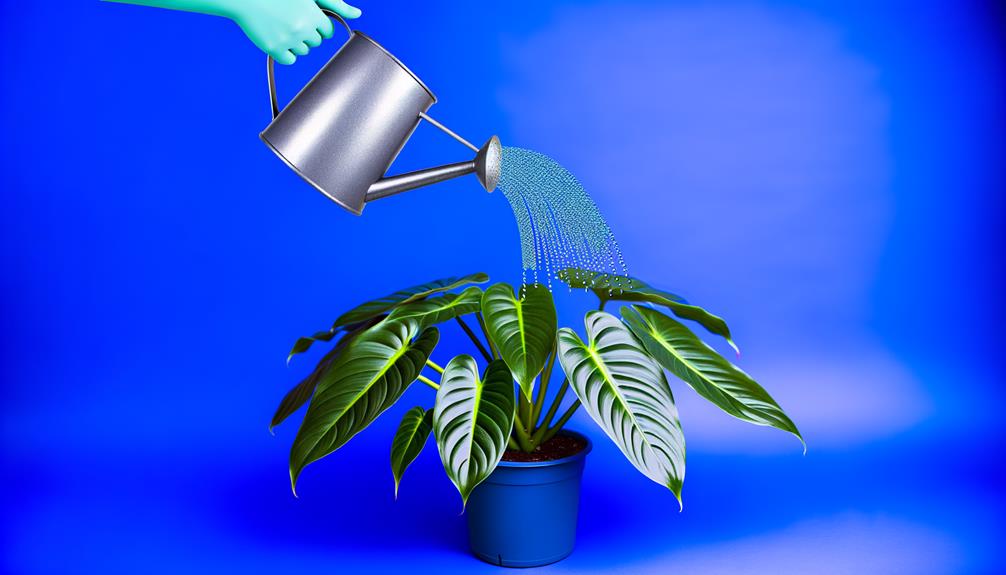
Understanding the watering regime for your Philodendron Billietiae is essential, as this tropical plant prefers a consistent, well-draining moisture level similar to its native rainforest habitat. Over-watering can lead to root rot, a common problem with these plants. Conversely, under-watering causes the leaves to droop.
To prevent these issues, it’s recommended that the soil should be allowed to dry out slightly between waterings, but not completely. The top inch of the soil can be used as a gauge for this; if it’s dry, it’s time to water the plant.
Moreover, the quality of water matters. Hard water contains minerals that can build up in the soil and harm the plant. Hence, the use of distilled or rainwater is advised to maintain the health of your Philodendron Billietiae.
The Right Soil Mix
Choosing the appropriate soil mix is a crucial aspect of caring for your Philodendron Billietiae, as it directly impacts the plant’s health and growth.
- Well-Draining Soil: Philodendron Billietiae thrives in a well-draining soil mix. Excessive water retention can lead to root rot, a common issue for this plant.
- Loamy Soil: A loamy mix, composed of silt, sand, and a bit of clay, provides the right balance of drainage and moisture retention.
- Organic Material: The incorporation of organic matter, such as compost or peat moss, enriches the soil with necessary nutrients.
- Slightly Acidic Soil: Philodendron Billietiae prefers slightly acidic soil with a pH range of 6.0 to 7.0.
Following these parameters will guarantee a healthy environment conducive to the best growth and essentiality of your Philodendron Billietiae.
Temperature and Humidity Preferences
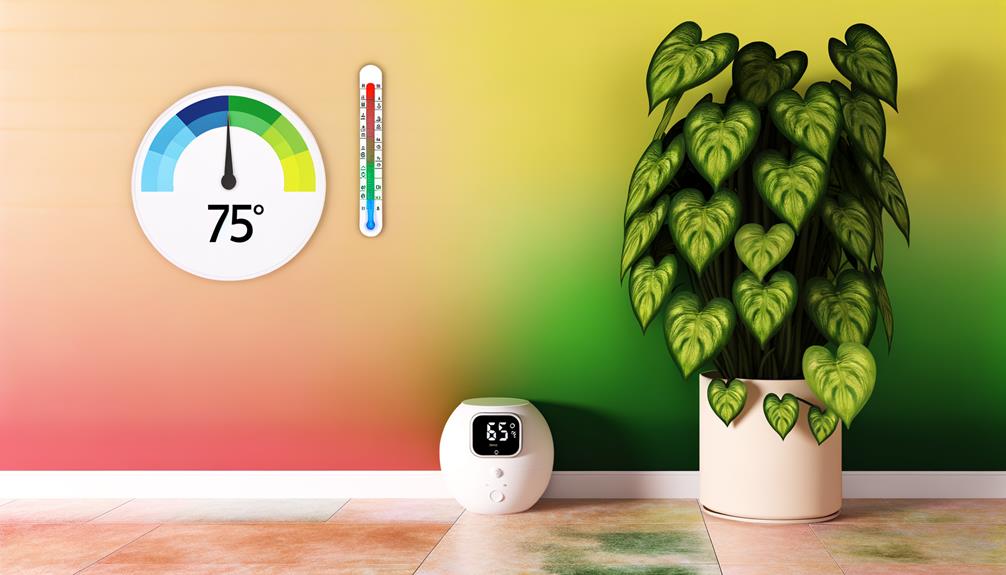
In the domain of temperature and humidity, Philodendron Billietiae exhibits a preference for conditions that mirror its native tropical rainforest habitat.
As a thermophilic species, it requires a consistent temperature range of 65-85°F (18-29°C) to maintain physiological processes. Temperature fluctuations or prolonged exposure to colder climates could lead to metabolic disturbances and frost damage.
Concurrently, humidity levels of 60-80% emulate the plant’s indigenous humid environment, supporting transpiration and nutrient absorption. Lack of humidity might lead to leaf desiccation and stunted growth. Hence, it is advisable to employ a humidifier or a pebble tray with water to maintain ideal humidity.
Understanding and providing these specific temperature and humidity conditions are paramount to the successful cultivation of Philodendron Billietiae.
Pest Control and Pruning Techniques
Maintaining the health and aesthetics of Philodendron Billietiae necessitates the application of appropriate pest control methods and regular pruning techniques.
- Pest Control: The Philodendron Billietiae is susceptible to pests such as aphids and spider mites. Regularly check the undersides of leaves and stem joints. Use organic insecticides or a mixture of water and mild dish soap to treat infestations.
- Pruning: Overgrown or dead leaves should be pruned to maintain the plant’s aesthetics and health. Use sharp, sterilized shears to prevent disease transmission.
- Disease Prevention: Regularly inspect the plant for signs of fungal or bacterial diseases. Early detection and treatment can prevent severe damage.
- Sanitation: Keep the plant and its surrounding area clean to prevent pest infestation and disease spread. Regularly remove fallen leaves and debris.
Does Philodendron Billietiae Climb
Yes, Philodendron billietiae is a climbing plant that can grow quite tall.
Here are some key points about its climbing habits:
- Philodendron billietiae is a hemiepiphytic vine, meaning it spends part of its life cycle as an epiphyte attached to trees before sending roots down to the soil.
- It uses aerial roots to climb up tree trunks, walls, trellises, moss poles, or any other suitable support. The aerial roots attach themselves to surfaces as the plant grows.
- In the wild, it can climb up to 65 feet (20 meters) or more on large trees in tropical rainforests. The leaves get much larger in size as the plant climbs higher.
- As a houseplant, it requires some kind of support structure like a moss pole, stake, or trellis that it can climb up and attach to with its aerial roots. This allows the plant to grow upwards rather than trailing.
- Without support, the vines will trail and spread out as a ground cover. But they will grow larger leaves and be healthier overall if provided a moss totem, plank of wood, or other coarse surface to climb.
So in summary, Philodendron verrucosum is a true climbing aroid that does best when given a support structure to climb and aerial root into. The aerial roots provide structure and nutrients to fuel the plant’s growth and mature foliage.
Conclusion
To sum up, the Philodendron Billietiae’s care requirements are relatively simple, yet meticulously precise. It craves a delicate balance of indirect light, regular hydration, specific soil mix, and a warm humid environment.
Vigilant pest control and pruning can enhance its majestic appearance. The satisfaction derived from nurturing this magnificent plant to its full potential is nothing short of extraordinary.
This houseplant’s upkeep is an art form that embodies the quintessence of indoor gardening.

